This compact, pink-tinged city is a delight to discover on foot, from the shell-shaped Campo to the galleries full of soft-eyed Sienese madonnas. Siena is a Gothic city built on a human scale, and is effortlessly civilized and at ease with itself. Where monumental Florence has large squares and masculine statues, Siena has hidden gardens and moody wells. Siena has also made a virtue of conservatism; stringent medieval building regulations protect the fabric of the city.
In keeping with Sienese mystique, the city’s origins are shrouded in myths of wolves and martyred saints. The ancient republic flourished from 1147 until 1529, and shortly afterwards, Siena became part of the Tuscan dukedom. Change is anathema to the Sienese and the citizens are never more themselves than when celebrating the legendary Palio horse race. Still today, Siena’s tumultuous history as arch-rivals of Florence resonates in the souls of the Sienese, particularly during the Palio.
Siena
-
-
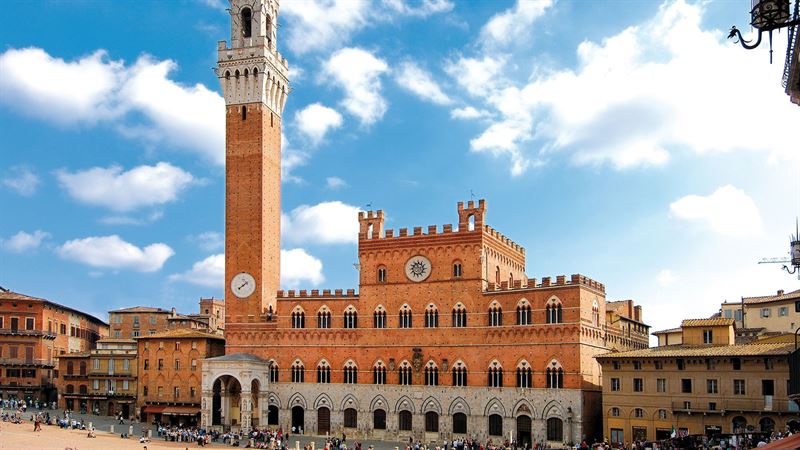
Things to do
Siena offers a gorgeous chiaroscuro main square, town hall and cathedral. But, in the end, it’s the intimate, medieval mood that lingers, from the secret alleys to the cosy inns.
-
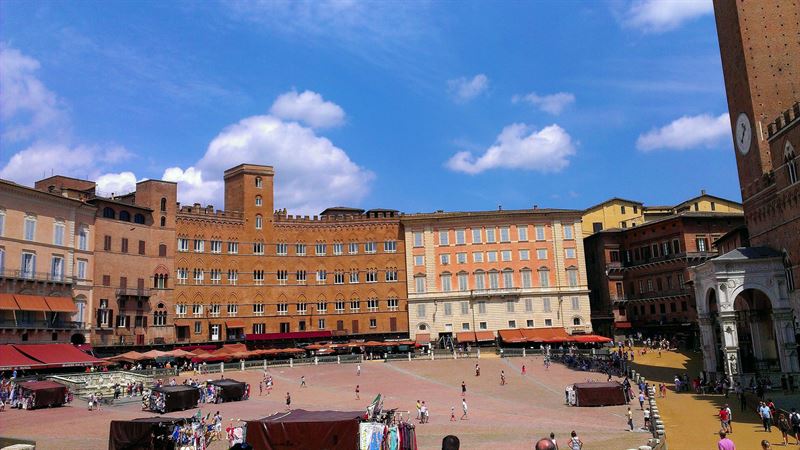
1. Il Campo – the loveliest square in Tuscany?
All roads lead to Il Campo, the beguiling, shell-like central square, shaped like an amphitheatre. Every year, the square celebrates the Palio horse race, the symbol of the Sienese attachment to their city. The Palio has raced through war, famine and plague. The locals liken the Campo to the protective cloak of the Virgin, who, with St Catherine of Siena, is the city’s patron saint. Sit at a terraced café on the sloping side of the square and spot the division of the paved surface into nine segments, recording the wise Council of Nine who governed Siena from the mid-13th century to the early 14th. This period of prosperity saw the creation of most of the main monuments. Look out for the Renaissance fountain that crowns the square. The marble Fonte Gaia (Fountain of Joy) contains copies of sculptures by Jacopo della Quercia, with the originals in Santa Maria della Scala.
-
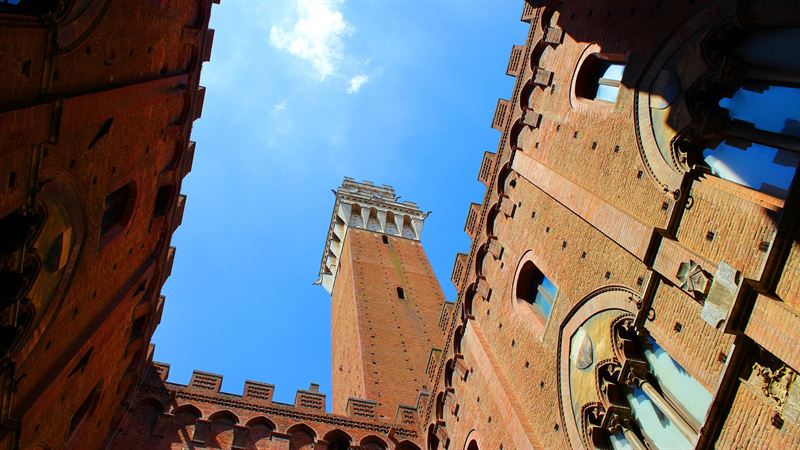
2. La Torre del Mangia - tower with a view
The slender Torre del Mangia is named after the first bell-ringer, Mangiaguadagni, `the spendthrift.’ Posterity confirms that he spent well on this lovely 87-metre-high tower, with its 500-step climb to the top. The reward for visitors is sultry views over a pink piazza and Siena’s rooftops, even if the views from the Cathedral rooftops are even better. At the bottom of the tower, the Cappella in Piazza (Chapel in the Square) was erected in 1378 in thanksgiving for the end of the plague. In 2017, after a Palio win, excitable citizens accidentally set the tower on fire with blazing torches but the tower survived. There’s no pre-booking so you need to just turn up (or used a combined ticket).
Address: Piazza del Campo, Siena
Web: www.comune.siena.it -
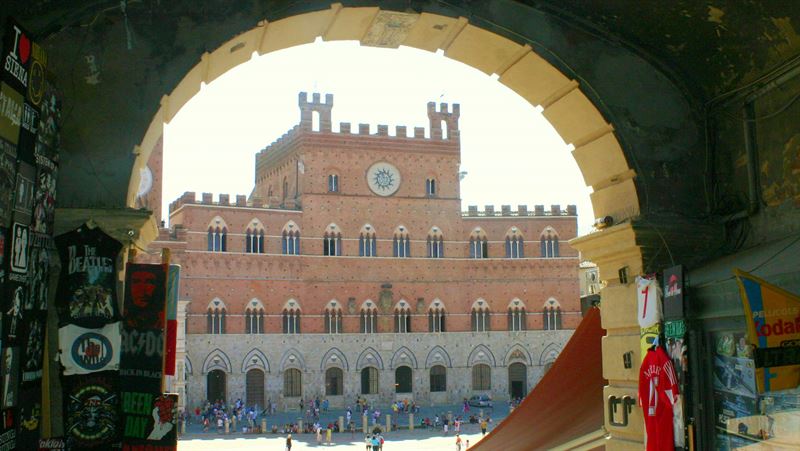
3. Il Palazzo Pubblico – the centre of civic life
At the bottom of the Campo stands the Palazzo Pubblico, the grandiose Town Hall, surmounted by the tall and slender tower. The Town Hall has been the centre of civic life since it was completed in 1310. Outside, this part of the square is still the place for gathering after a victory or defeat in any field, and also the place for meeting friends at any time of day. With its crenellated façade and waving banners, the Town Hall is a Gothic masterpiece of rose-coloured brick and silver-grey travertine. Each ogival arch is crowned by the balzana, Siena’s black-and-white emblem representing the mystery and purity of the Madonna’s life. Although bureaucrats still toil in parts of the Palazzo Pubblico, as they have for some seven centuries, much of the complex is now dedicated to the Museo Civico.
Address: Piazza del Campo, Siena
Web: www.comune.siena.it -
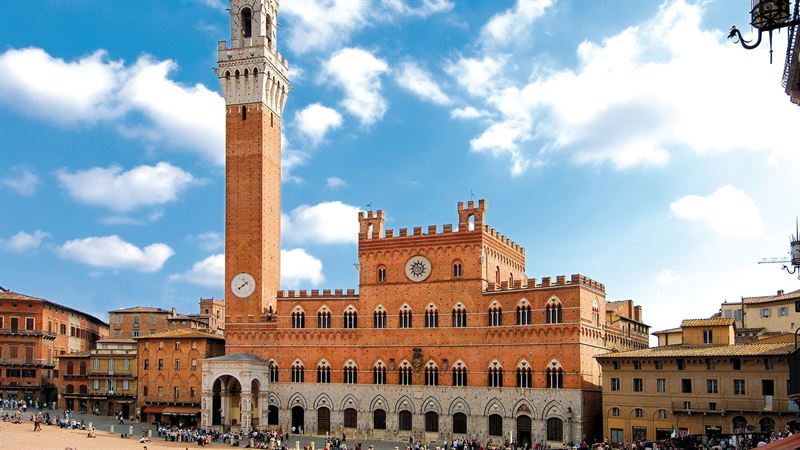
4. Il Museo Civico - top city museum
This magnificent city museum houses some of the city’s greatest treasures. Siena’s city council once met in the vast Sala del Mappamondo, although the huge globe that then graced the walls has disappeared. The Museo Civico showcases medieval city art with a moral message for all masters. Here, too, is Simone Martini’s Maestà, a dreamy Madonna seated on a filigree throne. Bringing us down to earth is a portrait of a medieval mercenary, the haughty Guidoriccio. Siena has always hedged her bets. This diamond-spangled condottiero (mercenary) is reproduced on calendars and panforte boxes. But in recent years, despite Sienese denials, doubts have been cast on the authenticity of the fresco. Art historians maintain that a smaller painting uncovered below the huge panel is Martini’s original, and that the work we see was executed long after the artist’s death. Instead, Lorenzetti’s Allegory of Good and Bad Government, painted in 1338, shows prosperity as a patchwork of neat fields and busy hoers. Bad Government is a desolate place, razed to the ground by a diabolical tyrant, the Sienese she-wolf at his feet. The realism and vivid facial expressions give the allegory emotional resonance.
Address: Piazza del Campo 1, Siena
Web: http://www.enjoysiena.it/it/attrattore/Museo-Civico/ -
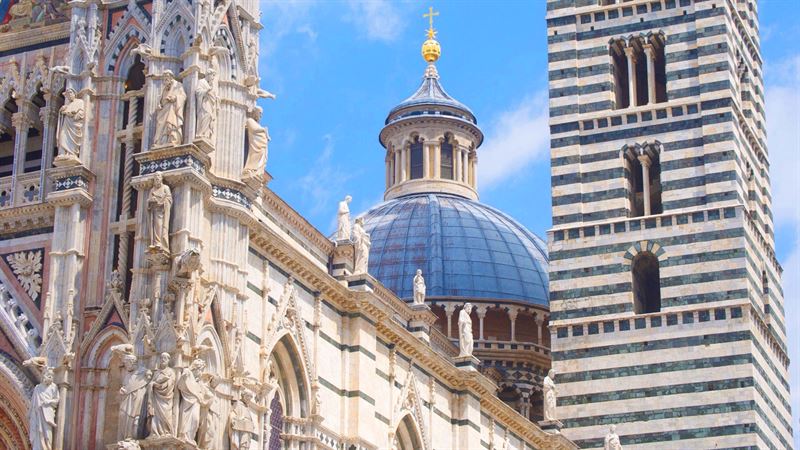
5. Il Duomo – moody cathedral
Siena Cathedral faces Santa Maria della Scala. The pinnacled Gothic facade is a riot of green, pink and white marble, like a glorious iced cake. The Duomo began in 1220 as a round-arched Romanesque church but soon acquired a Gothic façade festooned with pinnacles. Bands of black, white and green marble were inlaid with pink stone and topped by Giovanni Pisano’s naturalistic statues. The Cathedral interior is creativity run riot – oriental abstraction, Byzantine formality, Gothic flight and Romanesque austerity. A giddy chiaroscuro effect is created by the black-and-white walls reaching up to the starry blue vaults. The inlaid floor is a marvel but often hidden from view. Sienese craftsmen worked on the marble pavimentazione between 1372 and 1562. Giorgio Vasari called these “the most beautiful pavements ever made.” Nicola Pisano’s octagonal marble pulpit is a Gothic masterpiece but is currently being restored. Built in 1226, it is a dramatic and fluid progression from his solemn pulpit in Pisa Cathedral. Unearthed in 1999, the crypt is an extraordinary discovery, with frescoes attributed to Duccio’s school. Because the frescoes were perfectly concealed for so long, the intensity of the colours shines through in a vivid array of blue, gold and red. Given that the frescoes date from 1280, the `modern’ expressiveness is all the more remarkable. Also below the cathedral, and included in the ticket price, is an immersive 3D video-mapping experience.
Pass: the Opa Si Pass is valid for three days and includes entry to the Cathedral, Library, Baptistery, Crypt, Gate of Heaven, Museo dell’Opera and Panorama.
Address: Museo dell’Opera, Piazza del Duomo, Siena
Web: www.operaduomo.siena.it -
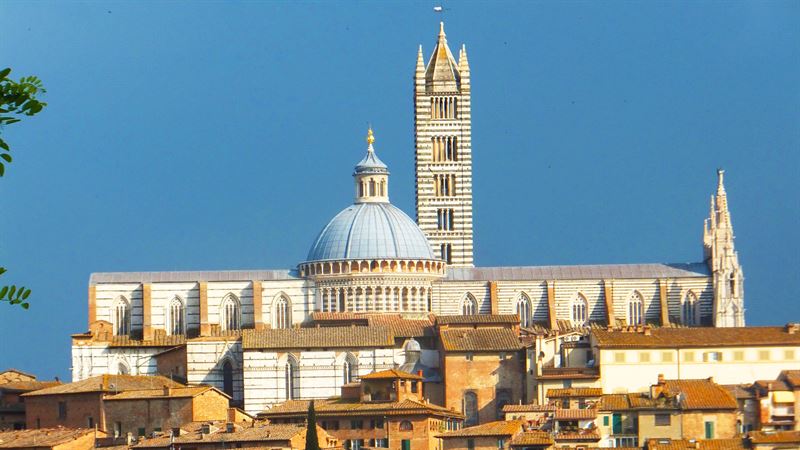
6. Museo dell’ Opera Metropolitana – art, sculpture and rooftop panorama
The Cathedral and the Cathedral Museum should be seen as one entity as they share several spaces. The Museum is set in the eastern section of the Cathedral and displays Pisano’s original statues for the façade. Instead, Siena’s best-loved work is Duccio’s Maestà, the Virgin Enthroned, which graced the High Altar until 1506. This, the largest known medieval panel painting ever, was escorted from the artist’s workshop to the Duomo in a torchlit procession in 1311. Although Byzantine Gothic in style, the painting is suffused with melancholy charm. The delicate gold and red colouring is matched by Duccio’s grace of line, which influenced Sienese painting for the next two centuries. The Sienese believe that Giotto copied Duccio but sacrificed beauty to naturalism.
For many visitors, even more impressive is the rooftop walk, known as the Panorama from the Unfinished Façade. These are arguably the finest views of Siena. The sunset view from the parapets is a summary of Siena: a red-brick medieval masterpiece. The so-called Gate of Heaven also gives you access to the roof of the Cathedral. It’s a walk above the star-spangled vaulted nave, which reveals inside-outside vistas of the Cathedral and cupola.
Pass: the Opa Si Pass is valid for three days and includes entry to the Cathedral, Library, Baptistery, Crypt, Gate of Heaven, Museo dell’Opera and Panorama.
Address: Museo dell’Opera, Piazza del Duomo, Siena
Web: www.operaduomo.siena.it -
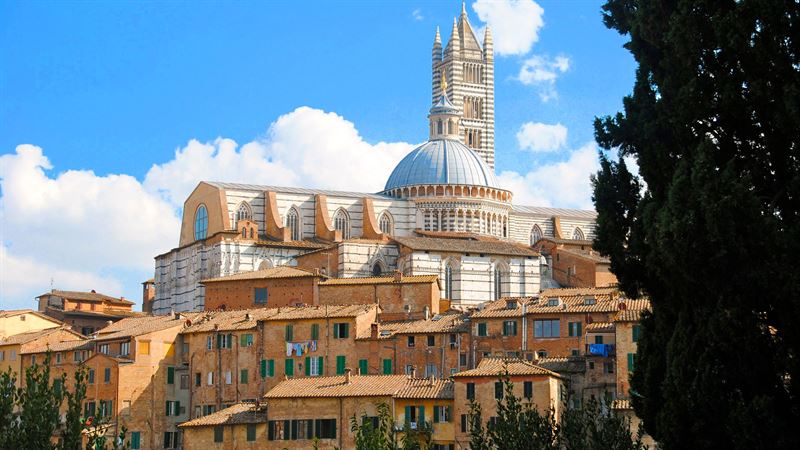
7. Santa Maria della Scala - `city within a city’
Facing the cathedral is the most extraordinary building in Siena. It began as a hospital a thousand years ago and continued as one until it was reborn as a magnificent museum and exhibition centre. In medieval times, it was always more than a hospital. The art-studded complex embraced a pilgrims’ hostel, a poor-house, an orphanage, frescoed churches and granaries. Often described as a city within a city, it can all be visited on a tunnel-like trail. Symbolically, the hospital door never had a key, proof of its role as a sanctuary to all-comers. The Pilgrims Hall, depicting care for the sick, is frescoed by Siena’s finest 15th-century artists. The frescoes of wet-nurses, almsgiving and abandoned children reveal a human side of the city absent from the luminous sacred art. New video installations illuminate key elements but don’t distract from Santa Maria’s grandeur.
Address: Spedale di Santa Maria della Scala, Piazza Duomo 2, Siena
Web: www.santamariadellascala.com -
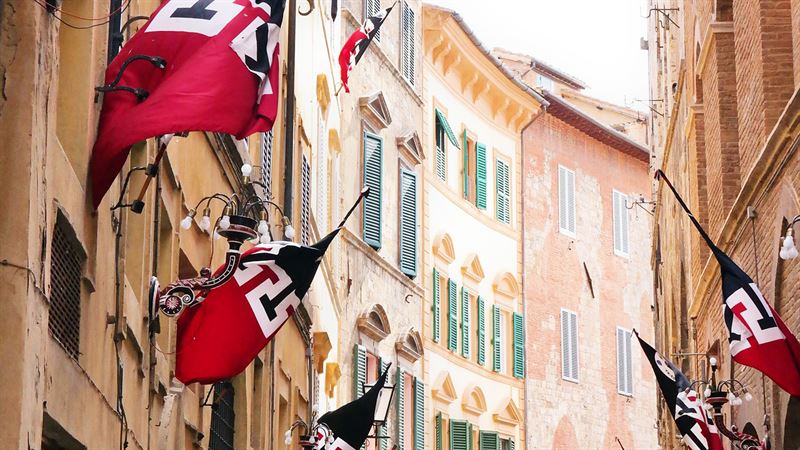
8. City backstreets walk
Focusing on the major monuments shouldn’t blind you to the beauty of the backstreets. Here, the city history unfurls like a medieval banner. Walkable Siena has well-preserved walls and inviting gateways. Wind through a tangle of medieval streets and stumble across secret courtyards, fountains and surprisingly rural views. Take the countrified lane of Via del Fosso di Sant'Ansano, which runs behind Santa Maria della Scala. Or explore St Catherine’s former home and neighbourhood of Fontebranda (Costa di Sant’Antonio). Stroll to Santa Maria dei Servi to lap up equally moody views and a sublime church. Escape the summer crowds by hugging these backstreets or simply take a thematic walking tour. Everywhere leads back to the Campo, at its most theatrical in the late afternoon, after a day spent in the shadows of the city walls.
Web: www.guidesiena.it -
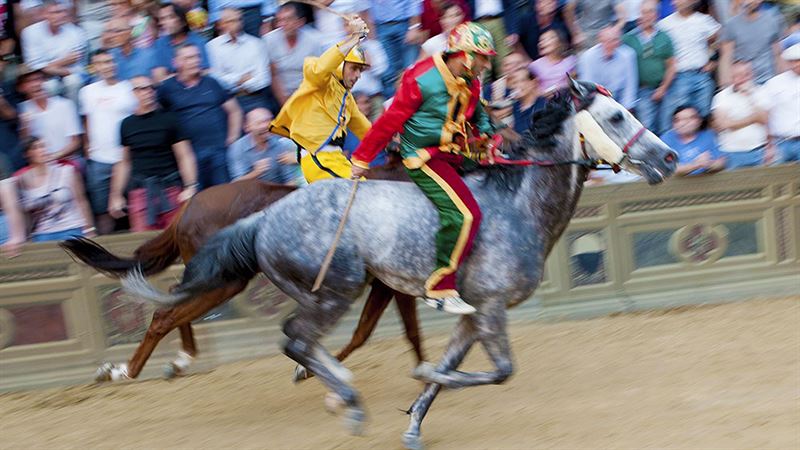
9. Contrade tour – city neighbourhoods
Siena’s distinctness owes much to the contrade, the 17 city wards created during the Middle Ages. These neighbourhoods still symbolise the Sienese’ sense of belonging: every community has its own flag, fountain and font, as well as its own motto, museum and church. Plaques on the walls testify to which contrada you are in, ranging from Wolf to Owl, Unicorn, Caterpillar or Goose. Baptisms and deaths are celebrated collectively, while a traditional Sienese will only marry within his or her contrada. The power of the contrade can be felt during the Palio horse race, which commands the passion of the whole population. Every neighbourhood spurs their rider on to victory. To get to grips with this secret world, book a contrade tour around the individual museums, churches and stables.
Web: www.guidesiena.it -
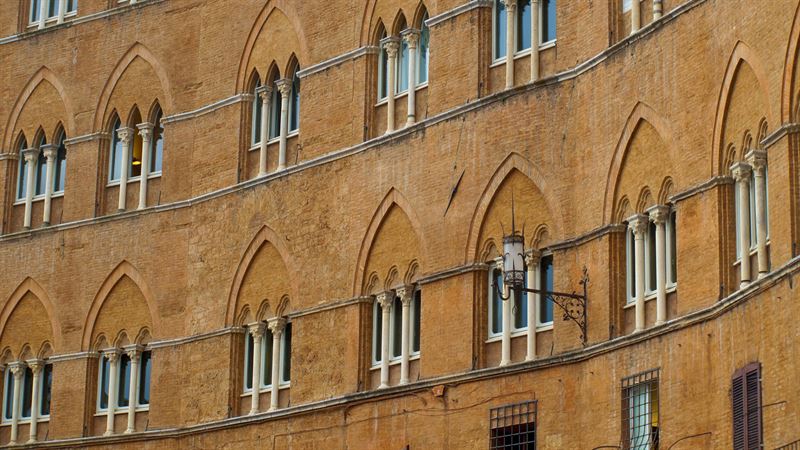
10. Pinacoteca Nazionale – Sienese showcase
This major picture gallery displays the finest collection of Sienese art in a suitably Gothic Palazzo. The early rooms are full of madonnas, apple-cheeked, pale, remote or warmly human. Matteo di Giovanni’s stylised Madonnas shift to Lorenzetti’s affectionate Annunciation and Ugolino di Neri’s radiant madonna. Neroccio di Bartolomeo’s Madonna is as truthful as a Masaccio. As a variant, the grisly deaths of obscure saints compete with a huge medieval crucifix with a naturalistic spurt of blood. The famous landscapes and surreal Persian city attributed to Lorenzetti were probably painted by Sassetta a century later. But his Madonna dei Carmelitani is a sweeping cavalcade of Sienese life.
Address: Palazzo Buonsignori, Via San Pietro 29, Siena
Web: http://www.enjoysiena.it/it/attrattore/Pinacoteca-Nazionale-di-Siena/ -
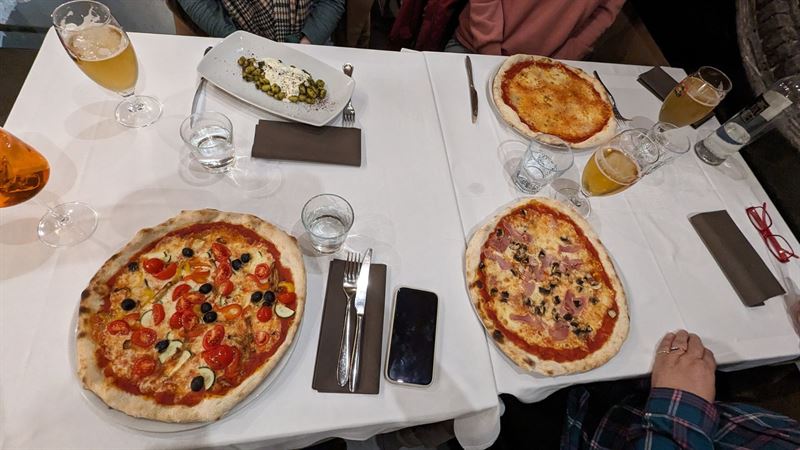
Eating and Drinking
This is a seriously foodie area, with hearty cuisine matched by Sienese regional wines ranging from the simpler Rosso di Montalcino to the more structured Brunello di Montalcino. Robust peasant dishes are popular, such as zuppa di fagioli, bean soup, crostini with chicken liver, tagliatelle with truffles, or homemade pici pasta with meaty sauces.
The Sienese also have a sweet tooth, and pastries have their own saint watching over them, San Lorenzo (St Lawrence). Panforte, a rich, filling, fruit, nut and honey cake, dates back to 1205, and is often eaten accompanied by sweet Vin Santo. Panpepato, a spicier version, pre-dates it. The delicacy was originally the preserve of Sienese nuns, who guarded their secret recipes, which were also a source of revenue. When footsore, retreat to an historic café to sample the best pastries - see Shopping. Also see Eating and Dining in Montepulciano, Pienza, Val d’Orcia. -
Osteria Le Logge
Just off the Campo, this retro, gourmet inn serves light, playful takes on Tuscan classics. This reliable, upmarket restaurant is set in an old-world pharmacy and herbalist's, with an authentic dark-wood and marble interior. The locals appreciate the antipasti and pasta, along with the rabbit and pigeon dishes. The wine list includes the owners’ wine and oil from their Montalcino estate.
Address: Via del Porrione 33, 53100 Siena
Web: www.osterialelogge.it -
Ristorante Il Porrione
In terms of design, the interior is classic Tuscan rustic-elegant style, with exposed brick walls, just off the Campo. Instead, the dishes are distinctly creative and international, with an exceptional wine list to match. Run by an owner-chef, this pricey fine-dining spot serves inventive dishes, such as soup with cherries and prawns. Be prepared for culinary surprises.
Address: Address:Via del Porrione 28, 53100 Siena -
Antico Osteria Da Divo
This romantic restaurant adjoins the medieval city walls. The main (medieval) dining room is far better than the musty vaulted Etruscan caverns, which are much like dining in an Etruscan tomb. The menu is Tuscan with a twist. Starters include Tuscan cured meats or Pecorino cheese Soufflé served with Chianti Classico wine reduction. Florentine steak, funghi porcini risotto or wild boar with roast vegetables might follow. In season, the truffle-tasting menu features truffles from the `Crete senesi’, the moonscape south of Siena. Depending on the dish, menus are mid-priced or above.
Address: Via Franciosa 25- 29, 53100 Siena
Web: www.osteriadadivo.it -
Enoteca I Terzi
This good-value inn and wine bar is about the mood as much as the food. Bare-brick walls set the tone for a place that incorporates a medieval tower. The inn is essentially laidback and welcoming, with a traditional Tuscan menu. Regulars come for filling antipasti, pasta, grills and Tuscan `Chianina’ steak. Another popular dish is pici al ragu, meat sauce with the chunky spaghetti favoured in Siena. The inn prides itself on not imposing a cover or service charge.
Address: Via dei Termini 7, 53100 Siena
Web: www.enotecaiterzi.it -
Gino Cacino
This snack bar and delicatessen is handy for a tasty lunch on the run. Set near the Campo, on one of the city’s prettiest squares, it is run by an affable Tuscan foodie. The specialities include meat or cheese-filled panini, washed down by a glass of wine. Gino’s devotion to cheese means he’s dubbed `King of Parmesan and Pecorino.’ Try the cheeses, from Gorgonzola and Taleggio or go for Sienese salami and porchetta, or artichokes and tomato salad.
Address: Piazza del Mercato 31, 53100 Siena -
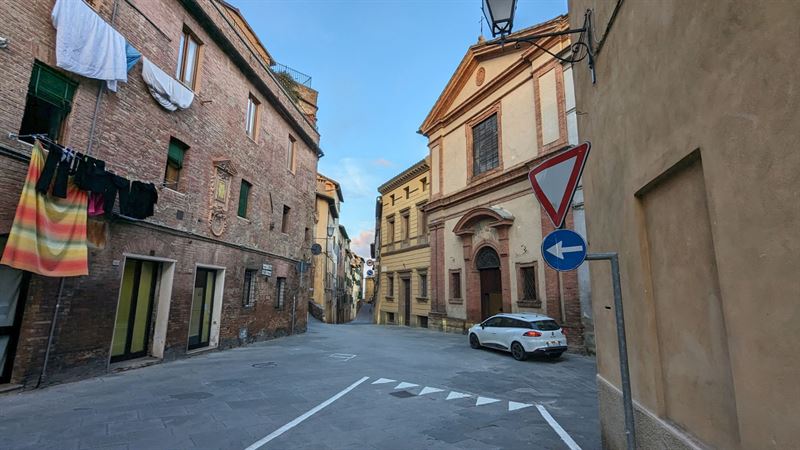
Shopping
The main shopping streets are Via Banchi di Sopra and Via di Città. Don’t expect glitzy malls and shopping centres. Sienese shopping is like the city: low-key and small-scale. Siena is full of tempting food shops, chic boutiques and quirky craft shops. Tuscan treats, such as oil, wine, pastries and cheeses, are the best buys. The Wednesday morning main market curves around the Fortezza Medicea, the Medici fortress and La Lizza. Browse for cheap clothes, leather bags and foodstuffs.
-
Nannini
The most famous place for panforte is both a bar and pastry shop, and run by the family of pop star, Gianna Nannini. Panforte, a spicy Sienese cake, used to be considered a Christmas or festive treat but is now eaten all year round. The intense flavours are created by the mix of honey, almonds, hazelnuts, candied orange peel, and a secret blend of spices such as cinnamon and nutmeg.
Address: Bar Conca d’Oro, Banchi di Sopra 24, 53100 Siena
Web: https://en.nanninidolciecaffe.com/ -
Pasticceria Bini
This pastry shop occupies what was supposedly Duccio’s workshop, which explains the wide medieval doorway, needed for the artist to transport his masterpiece, the Maesta, to Siena cathedral. Come for ricciarelli, small, almond biscuits, which are far lighter than panforte.
Address: Via Stalloreggi 91, 53100 Siena -
Antica Drogheria Manganelli
Carved into the former stables of a patrician palace is another exotic shop for Sienese delights. Founded it 1879, this shop sells Sienese pastries. Exotic spices reached Siena along the Via Francigena pilgrimage route, and many find their way into the medieval recipes still used today.
Address: Via di Citta 71, 53100 Siena -
Parking & Getting Around
To savour Siena, simply trust your feet, remembering that the city is hillier than it looks. Siena is mostly pedestrianised so walking is one of the city’s greatest joys. Conversely, Siena is a nightmare for drivers so the car is best deposited in a car park for your visit. Medieval Siena was not designed for cars. The city is in a ZTL system (Limited Traffic Zone) so closed to most traffic in the historic centre. Car parks lie outside the city walls. The recommended one is Parcheggio Stazione (Piazzale Fratelli Rosselli) for the train station but also the centre, via a city bus (Tiemme service) that leaves every 15 minutes for the centre. There is also Parcheggio Il Duomo (Via del Nuovo Asilo) for the centre. Two other car parks, San Francesco and Santa Caterina/Fontebranda, have escalators going into the centre. For full parking information, see www.sienaparcheggi.com
-
Train, buses and taxis
Siena isn’t on a major train line so buses are generally a better bet. And the train station is less central than the bus station on Piazza Gramsci. If arriving by train (www.trenitalia.com) from Florence, you often have to change at Empoli. If arriving from Rome, change at Chiusi. Frequent buses connect Siena and Florence (1¼ hours, T: 0577 204111, www.tiemmespa.it) as well as San Gimignano, Montalcino and Montepulciano. Only use public transport if visiting Florence or the lovely hill-towns and wine estates around Siena. The main taxi rank is on Piazza Matteotti. Tipping is not expected.

























